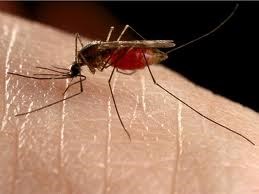So far, so good on the mosquito front.
For the second consecutive summer, the conditions for a high mosquito population in southeast Saskatchewan have existed, but for the second straight year, the mosquito bite count is down and the general population is pretty happy ... so far.
It's a never-ending battle to keep the pesky critters under control - just ask Larry Doan of Southeast Tree Care, the company that has been contracted to keep the mosquitoes at bay for the City of Estevan.
Southeast Tree Care has been awarded the mosquito control contract for several years now and as a result, Doan said they have been able to map, plan and attack the mosquitoes in the city's vulnerable areas on a regular basis with an ambitious larvicide program.
Wherever there are significant pools of standing water, you'll see the company's pickup and/or the ATV or any other vehicle that is needed, being deployed to lay down the organic chemicals that prevent the young mosquitoes from hatching and multiplying.
As in the past, Doan said they have divided the city and the immediate outlying perimeters into five sectors and began the mosquito eradication project this year as soon as the frost lifted.
As every resident of Saskatchewan realizes with mosquitoes, as with ants, you never get to win the battle completely, but you can gain control over the situation in spite of conditions that favour the enemy.
"We got a good start on the season, there are no areas of the city where the situation is out of control," said Doan. "We've been able to program in a preventative mode for the past few years."
That's the best way because the alternative is being in a reactive mode ... trying to put out the fires after they started, which can a frustrating job.
On the health front, there is also good news.
Although it's still relatively early in the season for the Culex tarsalis mosquitoes, the kind that carry the dreaded West Nile disease, the risk level remains low throughout all of central and southern Saskatchewan with zero cases reported and no positive pools or traps.
So far the general mosquito count taken from larger pools of water is Estevan is also less than last year, down about two-thirds of what it was in the early summer of 2010, said Doan. Of course last year there was a lot more standing water available thanks to the aftermath of the major flood.
"We hit each section of the city once a week. Some areas will always pose a bit of a challenge, like the Pleasantdale Valley or out by the lagoon ... the more difficult areas to get to, but we're able to get to them a lot easier this year compared with last year," Doan said.
The company usually dispatches a team of two to do the work in the morning since winds tend to pick up later in the day but even then, Southeast has picked up some tricks wherein the wind can work in their favour ... carrying the larvicide to where it needs to be, rather than carrying it away into an area where it's not needed.
"We can use it to propel product where we need it, of course it can also wash it to shore. We just don't try it in howling winds, but it's just not as difficult or limited as it was before," he said.
Except for the water levels, conditions this spring and summer have been similar to last year ... enough rain to keep everyone more than happy. Last year Doan said they had to switch their rotation a few times to hit the high mosquito concentration areas.
"The City has budgeted enough to keep the program active and we are able to go further out, which helps the RM residents a bit too. And the City allows us to do that when we see the need, so you'll sometimes find us on the outer edges and into the RM properties."
The contract has allowed Southeast Tree Care to purchase more specialized equipment over the years and Doan is convinced that laying down larvicide to catch the mosquitoes in the early stages is the right method as opposed to spraying pesticides and chemicals into the air and onto trees and bushes.
"That method can be tough on people, birds and animals. The larvicide we use is organic and it simply plugs up the larvae and prevents them from maturing and breeding the next generation. It's totally environmentally friendly. I just don't understand why some cities still use spraying programs."
So if you find yourself not having to slap away at the wily mosquito too often this summer, you can thank those who have developed a good battle plan that pretty well keeps them at bay.
In the meantime, the Ministry of Health reminds everyone that July, August and early September are the higher risk periods for the Culex tarsalis and it's the time of year when we humans like to spend more time outdoors.
While there were no reported West Nile cases in horses or humans last year, that doesn't mean the danger is gone so they recommend that we continue to use repellent containing DEET, wear protective clothing, reduce outdoor time at dusk and dawn, regularly clean and/or empty areas where water is collected (bird baths, eavestroughs, old tires and rain barrels) and keep the screens in doors and windows in good repair while keeping the yard clear of overgrowth and debris.




